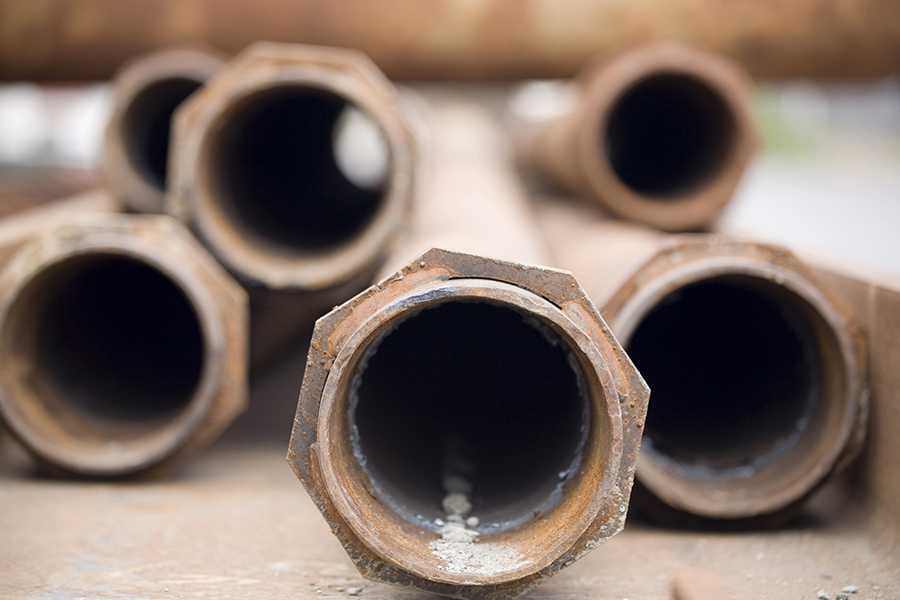In light of the water crisis in Flint, Michigan, PERC asked 2014 Julian Simon Fellow and economic historian Werner Troesken to provide clarity on the widespread use of lead water pipes and the associated health risks. Troesken has researched both water-borne lead poisoning and public utilities for over a decade.
Q: As the author of The Great Lead Water Pipe Disaster, can you describe what is happening in Flint, Michigan and provide some historical context?
A: In Flint, the city switched water supplies. The old supply, purchased from Detroit, was not as corrosive as the new supply from a nearby river. Because the new supply is corrosive, it leaches lead from the interior of the city’s pipes. It should be noted that it is not the city’s water mains that are made of lead, but rather the service pipes, or the pipes that connect homes and buildings to street mains.
What happened in Flint has many historical parallels. For example, an almost identical event occurred in Lowell, Massachusetts, during the 1890s, when the city introduced water from a new supply. Within a few years, hundreds of Lowell residents began to exhibit unmistakable signs of lead poisoning, such as wrist drop and a blue gum line. In one fatal case, the poisoned individual had been drinking tap water that contained lead levels 1,300 times greater than the current EPA standard for more than two years.
To give that number some context, in the early 1900s, it was not uncommon for women to use lead pills as abortifacients, which often resulted in severe cases of lead poisoning. In Lowell, you only needed to consume eight ounces of tap water per day to ingest the equivalent of the recommended daily dose of these lead abortion pills.
Q: What are some of the health effects of lead poisoning?
A: Lead affects multiple systems in the human body, including the central and peripheral nervous system, gastrointestinal tract, kidneys, and hematological system. Which of these systems is affected and to what degree depends on how much lead has been ingested.
Children are more vulnerable to lead because their systems absorb more lead than do adult bodies. Their developing systems are less able to withstand its toxic effects. Lead is a cumulative toxin, so repeated exposure does not produce immunity. Instead, repeated exposure to lead, even at low levels, causes the metal to accumulate in the body and produce more severe physiological damage.
In children, lead is associated with developmental delays, reduced vitamin D metabolism and nerve conduction velocity, and changes in the size and shape of red blood cells. At high levels, it is associated with more severe pathologies including reduced hemoglobin synthesis, colic, anemia, kidney failure, and brain swelling. The effects can even be fatal.
Q: What are some of the social effects of lead poisoning?
A: A small but growing group of economic historians have begun to study and quantify the effects of water-related lead exposure on a variety of outcomes including infant mortality, crime, educational attainment, intelligence, and long-term labor market outcomes. Studying data from the 1890s and early 1900s, the results of this research are startling and help to highlight why it is so important to treat water supplies to minimize their corrosiveness, as most cities do today, or to replace the lead pipes.
In terms of infant mortality, the data suggest the use of lead pipes in areas with highly acidic water supplies increased infant mortality by 10 to 25 percent. For some cities in Massachusetts with unusually corrosive supplies, lead pipes might have increased infant mortality by a factor of three or four. For the children who survived, the evidence suggests water-related poisoning had serious long-term consequences. Children who grew up in areas with corrosive water supplies and lead service pipes earned lower wages later in life, had lower educational attainment, scored lower on military intelligence exams, were less likely to own a home in mid-life, and were less mobile. The effects were especially pronounced among lower socioeconomic groups.
With any statistical analysis, one wonders about the role of confounding and unobserved variables: Perhaps the same things that caused people to locate in areas with corrosive water supplies, for example, might also be correlated with other sorts of unhealthy behaviors that impair long-term outcomes. That contingency seems unlikely here, in part because the relationship between negative outcomes and corrosive water supplies exists only in places with lead pipes. In places with iron pipes, corrosive water supplies do not have a negative impact on health outcomes in either the short or long run.
Q: Do lead pipes present a public health risk everywhere, or is there something unique about the situation in Flint?
A: As long as the water running through the pipes is not unduly corrosive (and has a pH close to neutrality), lead pipes can be safe. But when water supplies become highly acidic or alkaline, lead levels rise. That said, lead pipes are pervasive. Of the 50 largest cities in the United States in 1900, all but six or seven installed lead piping. In many large cities, lead service pipes were mandated by local building codes.
Q: Why did so many cities use lead?
A: It was not because lead was cheap. From an accounting perspective, lead cost more than most other piping materials. Engineers chose lead because it is durable. Compared to iron, it is less vulnerable to corrosion.
And the engineers were right: Most of those lead pipes in use in 1900 are still used today. There were a handful of doctors and public health officials who raised concerns about the safety of lead, but for the most part those concerns were dismissed as unfounded.
Q: In your book you argue that municipalities around the world were slow to respond to the public health threat posed by lead leached from water pipes. Why, historically, have policymakers been slow to react to water-related lead poisoning?
A: Historically, the reluctance to confront lead-poisoned water stemmed mostly from limited scientific understanding: Even the most well-informed observers tended not to fully appreciate the dangers lead could pose.
Q: With the decline in the domestic auto industry, Flint’s economy collapsed. Did that economic decline play a role in the current water emergency?
A: It sounds as though policymakers’ concerns about the cost of water prompted Flint to switch from buying its water from Detroit’s water utility to the Flint River, and that those same concerns prevented the city from taking steps to treat the city’s new water supply so that it would not be so corrosive.
Q: You conducted research on lead poisoning and other public health issues while visiting PERC as a Julian Simon Fellow. What is the role private companies play in domestic water supply?
A: Private provision of water can work well in settings where property rights are secure and private companies are confident that their capital investments in mains and filtration will not be expropriated through onerous regulatory policies and taxation. In the absence of institutional protections of their investments, private water companies are reluctant to fully invest in capital and public health can suffer as a result. In settings where it is not politically feasible to make such commitments, public ownership often emerges as a default option.
Q: Is it unusual for a community to struggle financially with the provision of basic services?
A: Although this is not directly related to lead water pipes, one of the biggest issues confronting cities historically was how to raise money to build their public water systems. Improving water quality, as I have explained in both articles and books, accounts for about 60 percent of the improvement in human life expectancy observed between 1850 and 1950.
On a per capita basis, investments in water systems were perhaps the largest public investment in American history, larger than the Panama Canal and the transcontinental railroad, for example. If a government wanted to borrow the money to build these systems, potential lenders had to be confident that cities, or the private enterprises operating the water system, would pay back the loans. Federal and state constitutions during the 1800s contained a number of provisions protecting creditors. These protections allowed cities and private companies to access credit markets, and borrow money, at much lower rates than they otherwise would have been able to.
Q: Can you give us a specific example of protections that encourage investment in sanitation and public health?
A: As an example, we can look to Pennsylvania, where laws passed in 1784 prevented cities from bouncing back and forth between water supplies “as whim or interest might dictate.”
The Pennsylvania legislature chose this institutional structure for good reason: to get water to the citizenry as soon as possible. As Pennsylvania’s supreme court later explained:
A municipality, in its beginnings, is perhaps not financially strong, or its debt may approach constitutional the limit so closely that it cannot borrow. Nevertheless the low state of its financial condition does not render less urgent the necessity of water supply. It can obtain it in but one way—by contract with those who have the money, and are willing to invest their private capital in the construction of waterworks.
Pennsylvania’s institutions were designed to ensure that Pennsylvania cities would purchase existing private water companies before building their own competing municipal systems. It does not perfectly mirror the current situation in Flint, where the city introduced a stopgap measure as it transitioned from one public waterworks to another. However, there is a lesson to be learned for governments in Michigan and elsewhere: statutory and contractual arrangements like those in Pennsylvania can enable cities to attract investments in urban water systems despite their relatively backward state of economic development.
In other words, it is possible for even poor places to design institutions that encourage private investments in public health and disease prevention.
Related reading from Werner Troesken and co-authors at the National Bureau of Economic Research:
The Significance of Lead Water Mains in American Cities. Some Historial Evidence.
This paper examines the use of lead in plumbing and water distribution systems and its effects on morbidity.
Lead and Mortality
The paper explores the effect of water-borne lead exposure on infant mortality.
Lead Pipes and Child Mortality
This paper examines the extent to which water-borne lead causes child deaths and IQ impairment.
Cognitive Disparities, Lead Plumbing, and Water Chemistry: Intelligence Test Scores and Exposure to Water-Borne Lead Among World War Two U.S. Army Enlistees
Using data from before the risks of exposure to lead were understood, this paper explores lead’s impact on mortality, intellect, education, and income.
Death and the City: Chicago’s Mortality Transition, 1850-1925
This paper asks what policies slowed mortality rates in American cities, and finds that the introduction of pure water explains between 30 and 50 percent of Chicago’s mortality decline.
Regime Change and Corruption. A History of Public Utility Regulation.
This paper explores how public utility regulation has evolved over time, and asks whether corruption is endemic to public utility industries.




